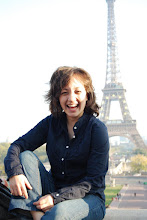Friday, February 27, 2009
Looking for something ridiculous?
Tuesday, February 24, 2009
Oscars vs. Jekyll and Hyde
Monday, February 23, 2009
Sunday, February 22, 2009
Damn it
Under Broadway, the Subway Hums Bernstein
Yes, of course, Suzette McLaurin says, she knows the musical “West Side Story,” and yes, she has been a conductor on the No. 2 train for quite a while — nearly eight years.
So along the way, has she heard the electronic whine from the trains that sounds just like the beginning of “Somewhere,” a ballad from the show?
This is not the kind of question Ms. McLaurin ordinarily fields during the 30 seconds or so that her train stops in the Times Square station. She leans slightly through the window.
“When the train is moving?” she asks.
Just when the train is starting, as if the cars were screeching, “There’s a place.”
“I never noticed it,” Ms. McLaurin says.
Once heard, it is unmistakable: an echo of “Somewhere” that rises from the ceaseless tide of shrieks and moans in the subways.
A revival of “West Side Story” begins previews next week, but this little piece of it has been playing nonstop beneath Broadway since 2000, when new cars began rolling with an innovative propulsion system. Most of them are on the 2, 4 and 5 lines, and fresh audiences arrive daily.
To hear a love song from the undercarriage of a train, even fleetingly, qualifies as a found moment. But like Ms. McLaurin, not everyone is listening for it.
“We didn’t know it was there until one day a Times reporter called in 2002,” said Gene Sansone, the chief mechanical officer for the subways. “Then we went out and heard it for ourselves.”
The sound is a fluke. Newer trains run on alternating current, but the third rail delivers direct current; inverters chop it into frequencies that can be used by the alternating current motors, said Jeff Hakner, a professor of electrical engineering at Cooper Union. The frequencies excite the steel, he said, which — in the case of the R142 subway cars — responds by singing “Somewhere.” Inverters on other trains run at different frequencies and thus are not gifted with such a recognizable song.
The playwright Tony Kushner told New York magazine last year that it was his favorite New York noise. Riders often ask transit officials about it, and readers still write to the City section of The Times to report their discovery. The filmmaker Julie Talen told me about it months before I finally caught it.
When it’s heard by people who haven’t been tipped off, they distrust their own ears.
“Everyone sort of noticed it, and then this corroboration process started where people said to each other, ‘Did you hear it?’ ” said Jamie Bernstein, a writer and broadcaster whose father, Leonard Bernstein, composed “West Side Story.” “People still are asking me about it.”
How can a subway car evoke a song that has been fixed in memory by great singers like Marni Nixon, Aretha Franklin and Jessye Norman?
“What makes a melody sound like a melody is not the note it starts on — it’s the relationship from the first note you hear to the next one,” said John Mauceri, the chancellor of the University of North Carolina School of the Arts and a conductor who worked with Mr. Bernstein for 18 years.
What the mind knows as melody, Mr. Mauceri said, are these intervals between notes. “Our brains are built on pattern matching,” he said. “How does a finch recognize another finch singing from a tree a half-mile away? Once you have two or three intervals, they become locked in your brain as that song.”
In the first sung line of “Somewhere,” there are two intervals, Mr. Mauceri said. Between the first note — “there’s” — and the second note — “a” — the interval is known as an ascending minor seventh. From that second note to the third — “place” — there’s a descending half-step interval. The songs from “West Side Story,” which opened on Broadway in 1957 and was made into a movie in 1961, are often used to teach intervals to music students.
“What you’re hearing in the subway are the two intervals that remind you of the song,” he said. The same intervals can be heard in other pieces of music — for instance, in the second movement of Beethoven’s “Emperor” Concerto — but do not reside so prominently in memory as “Somewhere” because they are deeper in the music.
“ ’Somewhere’ is probably the only song that starts with them,” Mr. Mauceri said. “Or certainly it’s the most famous.”
The music was composed before the words, which were written by Stephen Sondheim, Ms. Bernstein said. “For a while, there was a dummy lyric to the tune,” she said, singing it: “There goes whatshisname.”
Naturally, the subway sounds also stir the Sondheim words from memory — a song of consolation for two lovers taken from each other by unyielding circumstance. And all this rises from three short blasts of high-pitched sound.
As her No. 2 train was leaving Times Square a few days ago, Ms. McLaurin scanned the platform. The train sang out, a breeze lifting a curtain. Her face lit up.
E-mail: dwyer@nytimes.com
Saturday, February 21, 2009
Sunday, February 15, 2009
Finding Pieces
Thursday, February 12, 2009
craigslist personals
Pliz, Miss. Mehbee yew kin be mein vife und mek mein modder heppy und stop kvetching. Dot vood be nice. So pliz enser dis ed kvickly. But send uh peekshuh mit yaw enser. Mein modder dont vant no meeskeit in mein mishpoche.


